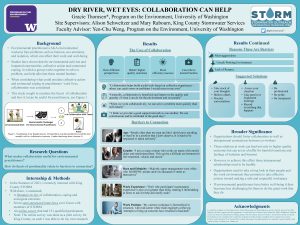DRY RIVER, WET EYES: AN EXPLORATION OF WHAT MAKES OR BREAKS COLLABORATION AS A TOOL FOR ENVIRONMENTAL PRACTITIONERS
Environmental practitioners on the front lines of environmental degradation face problems like harmful emotions as part of their job in the environmental field. These problems can place unnecessary and debilitating burdens upon practitioners that can sometimes feel quite isolating. When looking for a solution, I found that communal coping and collective action can help relieve people’s burdens, so I wondered how a similar concept, collaboration, could be used as a tool by practitioners to protect their mental health as well as progress their work. The aim of this study was to understand what makes or breaks collaboration as well as how positionality (age, race/ethnicity, gender, work position, work experience) can affect these collaborative connections. Interning with King County, I conducted semi-structured interviews and a survey. Through our research, we identified some of the ins and outs of collaboration. Practitioners enjoyed sharing different perspectives, better outcomes, and efficiency/success. However, collaboration does come with some downsides as the time it takes and the people involved don’t always contribute to the experience. Practitioner’s positionality and how they were treated/treated others was also confirmed as a barrier to connection, along with remote work. The implication of this research is that collaboration does ample good for environmental practitioners and their work and as such it is important to foster healthy collaboration within the environmental field. This research also highlights the importance of addressing how practitioners treat one another, as having safe and respectful connections is part of useful collaboration and overall well-being.
